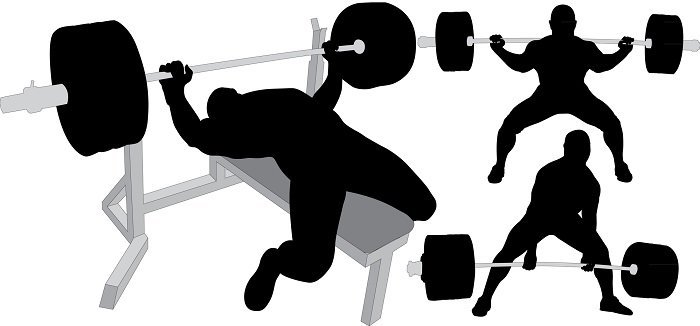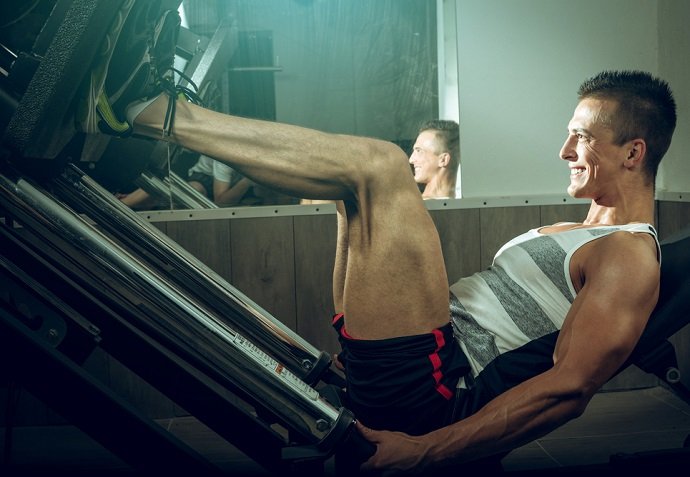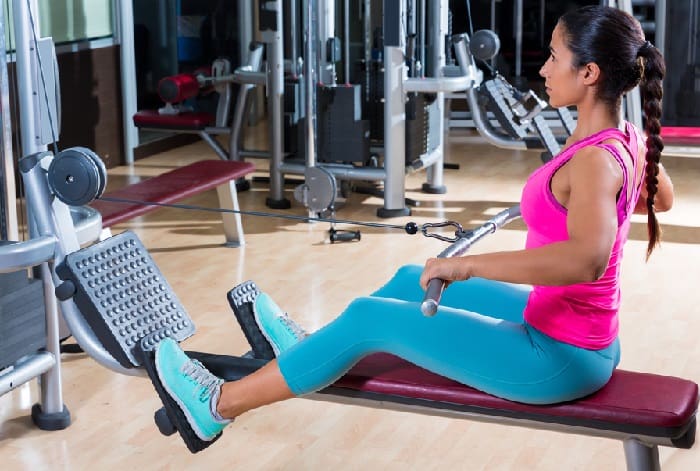You will hear it quite often – “Bro, what type of training split are you using?”, “Bro, what best workout splits should I use to gain muscle?”.
Well, the answer is simple…
The ultimate training split (or best workout split) does not exist.
That is simply because everyone has different goals, different levels of fitness, different individual characteristics, etcetera.
Even if the goal is the same, two people might need different splits, as a single workout split won’t work optimally for both of them.
YOUR ultimate training split however, should be built according to your individual characteristics, your goals, daily routine and schedule.
For today, we will show you the most commonly used training splits/means of working out. We will also discuss the pros and cons of each split, to help you finally pick one and start implementing it.
Full-body workout splits
By definition, a split workout is a regimen, which consists of separate workouts for separate muscle groups.
And while the full body circuits are not really considered split training, we will include them here and tell you more.
With full body workouts we basically train each muscle group, within one single workout.
Generally, we have 1 exercise per muscle group, done in 2-3 working sets.
Preferably, the exercises are compound movements, or in other words, movements that engage more than one joint and muscle at a time.
As each muscle group needs time to recover, the full-body workouts are generally done every other day- 3 to 4 times weekly.
We highly recommend taking at least 1 day of rest between the separate workouts.
The full body split is the perfect choice for beginners, who are looking to improve general health and physical properties – Strength, strength endurance.
With the full body split, you will also be learning the proper execution of each exercise, which is a must for every beginner trainee.
Related Guide: Complete tips for workout, fitness modules, foods & diet
Pros & cons of the full body workout split
Pros- Frequent muscle stimulation, expressed through moderate volume is your best bet if you’re trying to lose fat or build muscle.
With the full body workout, you can also increase strength substantially and use mostly compound movements.
Cons- If you’ve been doing full body workouts for some time, you will notably feel that it is not optimal for overall development.
That is because you can’t really emphasize on each muscle group.
Conclusion- The full body workout is best for beginners who are trying to develop basic physical properties and build a good foundation.
It is also the perfect choice for people who are trying to make general physical and health improvements.
It is sub-optimal for trainees who are strictly oriented towards aesthetic development.
Antagonist split

Is Antagonist split also considered one of the best workout splits in the gym? Definitely YES!
The antagonist split essentially involves 2 opposing muscle groups in one single workout.
Antagonistic muscle groups are basically two muscles attached in one joint, which are opposite in function and placement.
Example- Biceps’ antagonist is the triceps. Quadriceps’ antagonist are the hamstrings.
Sample split
- Day 1- Chest and back
- Day 2- Biceps, triceps and shoulders
- Day 3- Quadriceps, hamstrings and calves
- Day 4- Rest day
You can target the abs during day 1, since abs are the antagonist of the spinal erectors.
The antagonist split is perfect for intermediate and advanced athletes, who are looking to increase muscle mass and strength.
This split allows for high intensity work and moderate volume, making it perfect for building a pleasing to look at physique.
Pros & cons of the antagonist split
PROS: Spot-on for muscle growth.
Spot-on for getting shredded. Active rest is involved.
While the agonist is receiving contraction signals, the antagonist receives relaxation signals, leading to quicker recovery.
The split allows for 5 to 6 workouts weekly.
CONS: Not fit for beginners. Beginners who don’t pick the proper split will end up sub-optimally recovered.
Combined splits

The combined splits include training synergistic muscle groups during the same workout.
Synergistic muscle groups are two or more muscles that have the same function and work together for a certain action.
Example… Back’s synergists are the biceps and forearms.
Sample split
- Day 1- Back and biceps
- Day 2- Chest, triceps and shoulders
- Day 3- Quads and hamstrings
- Day 4- Rest day
Using such a split allows you to secondarily work on the synergistic muscle groups and afterwards, squeeze out the last of them with dedicated exercises.
The combined split is perfect for intermediate and advanced trainees, however, it is sub-optimal for beginners as it will result in an insufficient recovery.
Pros & cons of the combined split
Pros- Allows you to adjust workout frequency and rest days.
Cons- It is possible to experience insufficient recovery if your rest and nutrition are not properly optimized.
Push & pull split

The concept here is simple- You train pushing groups in one day and pulling groups in the other day.
The pushing muscle groups are- Chest, triceps, shoulders, quads, calves.
The pulling muscle groups are- Back, biceps, forearms, spinal erectors, hamstrings
Sample push/pull split
- Day 1- Push
- Day 2- Pull
- Day 3- Rest
- Day 4- Push
- Day 5- Pull
- Day 6 & 7- Rest
This workout split is a perfect fit for intermediates and advanced trainees, who are looking to stack on some lean muscle and improve overall strength.
Pros and cons of the push/pull split
Pros- You can plan your workouts well and have more than 2 rest days weekly. If the rest of your schedule is uncertain, then this is perfect for you.
Cons- Inapplicable for certain athletes, whose sport requires the body to work as a whole system.
Upper & lower workout splits

This one is quite intuitive- Upper body and lower body are trained on separate days.
Sample split
- Day 1- Upper body- Chest, back, shoulders, biceps, triceps
- Day 2- Lower body- Quadriceps, hamstrings, calves, lower back
- Day 3- Rest
Repeat.
It is considered that this split is appropriate for most fitness trainees.
Whether you are a beginner, intermediate or advanced, you can tweak the training parameters and make the best out of the upper/lower split, for your level of fitness.
Pros and cons of the upper/lower split
Pros- Legs are trained on a separate day, making it easy to complete a quality lower body workout.
The split also offers a flexible frequency of the workouts and quite a decent volume as well, making it perfect for both muscle building and strength gaining.
Cons- Inapplicable for people who are looking to emphasize on and improve a certain, lacking muscle group. Hard to maintain a substantial volume of each workout.
The bro split

Have you heard about the Bro Split? Is commonly referred as one of the best workout splits among beginners and pros
This is the most common split among trainees. The bro split implies training one muscle group per workout.
Sample split
- Day 1- Chest
- Day 2- Back
- Day 3- Shoulders
- Day 4- Arms
- Day 5- Legs
- Day 6 & 7 – Rest
This split can be used by more advanced trainees, who can take on a big load of volume during the workout.
Not recommended for people who are looking for consistent gains.
Pros and cons of the bro split
Pros- Allows you to choose and implement a variety of exercises, to target each muscle group under every possible angle. This also implies a big volume of the workout.
Cons- Leaves your muscles doing literally nothing for a couple of days.
Considering each muscle recovers for ~72-96 hours after a workout, this split leaves a 2-3-day window, during which the muscles are neither trained nor recovered.
Which split should you choose?
The splits above are the most common ones, known among fitness trainees.
However, there’s such a wide variety of training splits and exercises, that we can’t physically fit them all in one article.
But as we mentioned, there isn’t an ultimate split, good for everyone. Rather, there are many options and each one has pros & cons.
So here are a couple of tips, towards choosing your optimal split-
- Have CLEAR goals in mind
To have a well-structured regimen, you MUST know your goals.
Yes, you can be all-around well developed, but for example, if you want to be really strong- You’ll have to train with high intensity.
High intensity implies less volume, which means less muscle growth.
So, if you want to be really lean, with a detailed muscular development, but also want to be strong.. Well, pick one and prioritize it.
Generally, when it comes to developing optimal size, separations, symmetry and an overall pleasing to look at physique, strength gains will be just an accompanying aspect.
And vice versa- When you’re training with a powerlifting approach, muscle gains will not be the main outcome.
That is simply because training in the 1-3 rep range is only possible with an increased frequency of brain-to-muscle signals. That is to say that with this approach, your body prioritizes nerve paths’ development.
- Consider your weekly schedule
Make a plan. If you’re a busy person, set specific days and hours of the week, during which you can train in peace, without being worried about meetings.
You need to focus your full attention on the workout and not just go through it.
If your schedule is loose and you don’t know if you can or cannot workout on the next day, do full body workouts.
- Level of fitness
How fit are you? What have you trained before?
Determining your physical abilities in an objective manner is of prime importance.
For example, if you are a beginner, start off with 3-4 full-body workouts a week.
Once you build some strength and endurance, transition to an upper/lower split for example. Then, once you have trained for some time and feel adapted enough, go for a more advanced split.
- Proper recovery
Most of all, you need a good consideration about nutrition, sleep and rest period between each workout.
The split of choice must be properly combined with these factors. If not, no split will work!
Conclusion
There isn’t a unified training split, when it comes to weight training. We believe all above exercises mentioned qualified as best workout splits.
Consider your individual characteristics, current fitness level, injuries and weekly schedule.
Come to terms with your goals, and once you know what you want to prioritize, get right into it!
Products Guides:
https://www.slimtree.com/crazybulk-bulking-stack-reviews/
https://www.slimtree.com/mass-stack-review/
https://www.slimtree.com/crazy-cutting-stack-pack/
https://www.slimtree.com/cutting-stack/
https://www.slimtree.com/crazy-bulk-guide-reviews/
https://www.slimtree.com/anabolics-com/
https://www.slimtree.com/best-mass-gainer-vs-best-weight-gainer-supplements/
https://www.slimtree.com/legal-steroids/

